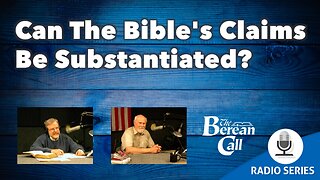Historical Evidence for Matthew's Gospel: Apostolic Authorship, Early Date, God's Infallible Word
The Gospel of Matthew was written by the Apostle Matthew under the infallible inspiration of the Holy Spirit. Matthew's Gospel was written around AD 40, and powerful evidence from history, archaeology, and prophech confirms Matthew is God's infallible Word and a flawless record of the words and deeds of Jesus Christ, the resurrected Son of God.
Opponents of the Bible make arguments based on assumptions that involve a rejection of the evidence that we have. They speculate, invent imaginary sources for the New Testament, make unverifiable assumptions about the impossibility of miracles, about early Christian history, and so on, and either ignore or reject what the actual facts of the New Testament point towards, because the evidence that we have provides amazing support for the New Testament.
The traditional view of the New Testament gospels and Acts is that Matthew wrote the Gospel of Matthew, Mark wrote the Gospel of Mark, Luke wrote the Gospel of Luke and the book of Acts, and John wrote the Gospel of John.
These documents are early accounts of eyewitness testimony to the life, death, and resurrection of Jesus Christ and the history of the early Christian churches. Christ’s promise—that He would, through the Holy Spirit, guide the writers of the New Testament into all truth, so that their writings would be an infallibly accurate historical record (John 16:13)—has been fulfilled.
Matthew was written by one of Jesus Christ’s Apostles (Matthew 9:9).
Matthew wrote his Gospel c. AD 40, that is, very shortly after Christ’s death and resurrection in AD 33. Matthew’s authorship of the gospel bearing his name, and its early date, receives overwhelming support from the extant historical sources. The ancient testimony to Matthew’s authorship of his gospel is unanimous, going back to our earliest surviving patristic testimonies, and there is no evidence that any other author was ever proposed.
Papias (born c. A. D. 60), who had direct contact with eyewitnesses of the Lord Jesus’ earthly ministry, who wrote around the end of the first century while the Apostle John was still alive, and of whom the earliest extant historical testimony indicates that he personally heard the Apostle John preach, declared in his five-volume Exposition of the Oracles of the Lord: “Matthew ... composed the gospel.” Similarly, Irenaeus, Origen, Eusebius, and Jerome validate Matthew's authorship.
Only in the eighteenth century A. D. did anti-Bible skeptics begin to question Matthew’s authorship.
The attributive headings of copies of Matthew unanimously testify to the Apostle’s authorship of his gospel.The unity of authorial ascription in the manuscripts stands in the sharpest contrast to the confusion present in the headings of pseudepigraphical writings.
Alongside the powerful case for the authorship by the Apostle Matthew of the gospel bearing his name, an early date for the gospel receives powerful confirmation.
The Biblical book of James, written in AD 45, shows a clear knowledge of Matthew. Matthew’s Gospel had to be written earlier. From the middle to late first century, the earliest extant post-Biblical writings of Christendom such as the Epistle of Barnabas, 1 Clement, the letters of Ignatius and Polycarp, and the Didache contain quotations from and allusions to Matthew as Scripture, clearly evidencing the existence of the Gospel by that time.
Internal evidence within Matthew support a date after the resurrection of Christ in AD 33, but by no means later than AD 70—the temple and city of Jerusalem, which were destroyed by Rome in AD 70, were still standing when the Gospel was composed. Indeed, the language of Matthew suggests that the twelve apostles were all still alive when he wrote, dating the Gospel before the martyrdom of James in AD 42 (Matthew 10:2).
The external evidence points specifically to c. AD 40. Many high quality Greek manuscripts record a very ancient tradition that Matthew was published eight years after the ascension of Christ, that is, in AD 41. Eusebius in his Chronicle placed the writing of Matthew in AD 41. Cosimas of Alexandria dated it very shortly after the crucifixion and resurrection of Christ, that is, c. AD 35. Subsequent writers on the subject such as Theophylact date the gospel between AD 38-41. The ancient historical evidence is unanimous that Matthew was the first Gospel written.
Papyus P64, a fragment of Matthew, has been dated to A. D. 60. There is no trace of a tradition that dates the gospel as late as the last decades of the first century—a date very shortly after the time of the events recorded in the gospels receives universal testimony.
The internal and external evidence strongly support the fact that Christ’s very close follower, the Apostle Matthew, wrote his eyewitness account of the life of Christ c. A. D. 40, only a handful of years after the events he recounts took place.
From the 2021 Word of Truth Conference at Bethel Baptist Church in El Sobrante, CA.
-
 55:02
55:02
KJBIBLE1611
9 months agoHistorical & Archaeological Evidence for the New Testament: Gospel of Matthew, Authorship & Date (1)
510 -
 7:58
7:58
Christian Writings
1 year agoThe New Testament Documents Are They Reliable? Chapter 6 The Importance of Paul's Evidence
3 -
 21:57
21:57
American Torah
1 year ago $0.06 earnedApostacy, False Prophets, and the Gospel in Mathew 24
85 -
 9:32
9:32
thebibleisart
2 years agoThe Literary Genius of the Structure of Matthew's Gospel
371 -
 7:24
7:24
FACTS vs. LIES!
5 months agoPope Franciscus Lucifericus Authorizes WEF To Rewrite 'Fact Checked' Holy Bible
93 -
 9:06
9:06
Andy042818
1 year agoActs 10 | Peter's Revelation to Take the Gospel to the Gentiles | The Bible
531 -
 23:15
23:15
Christian Writings
1 year agoGod's Evangel Being Gospel Papers, The Gospel in the Genealogy
8 -
 12:36
12:36
LetsReadTheBibleTogether
2 years agoDay 17 of Let's Read the Bible - Genesis 17, Matthew 17, Acts 17
8 -
 25:09
25:09
thebereancall
11 months agoCan the Bible's Claims Be Substantiated?
79 -
 4:11
4:11
Poimenchris
4 months agoUNLEASHING GOD'S WORD -MATTHEW 16 #AUDIOBIBLE #NEW TESTAMENT
7